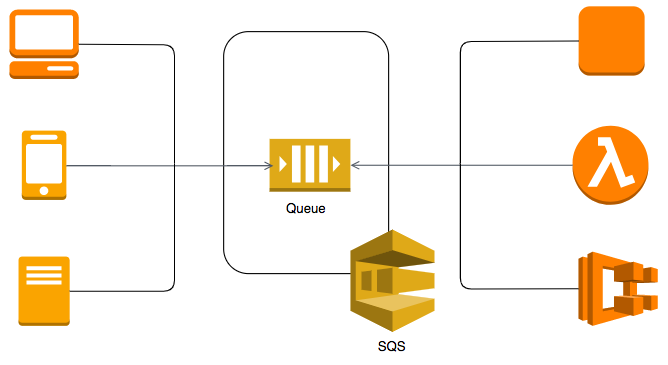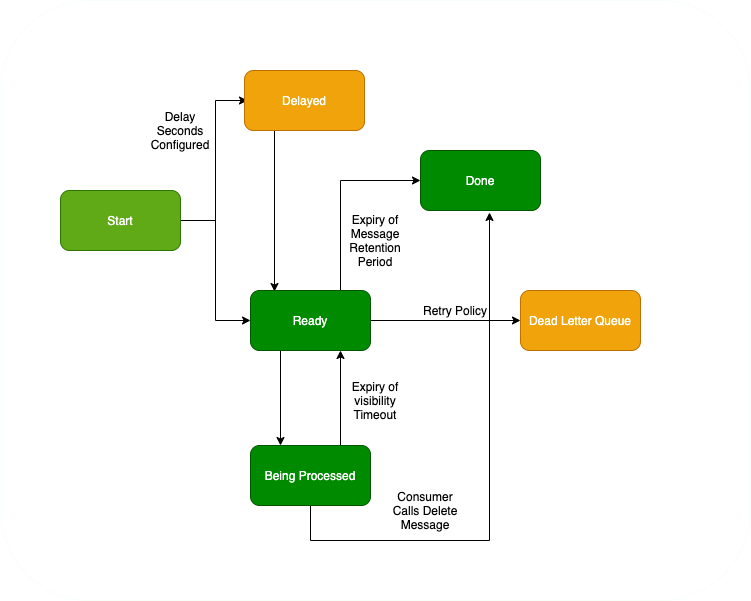Let’s get a quick overview of Amazon SQS from an AWS certification perspective. We will look at important certification questions regarding Amazon SQS.
You will learn
- What is Amazon SQS?
- Why do we need Amazon SQS?
- When do we use Amazon SQS?
- What is difference between FIFO vs Standard Queue?
- What are the steps involved in processing a message from Amazon SQS queue?
- How do you implement auto scaling with CloudWatch Alarms for SQS Queue?
Simple Queuing Service
Simple Queuing Service is a highly reliable, scalable, fully-managed message queuing service.
Here are some of the important features:
- High availability
- Unlimited scaling
- Auto scale to process billions of messages per day
- Low cost (Pay for use)

Two Types of Simple Queuing Service Queues
There are Two Types of Simple Queuing Service Queues:
- Standard Queue
- Unlimited throughput
- BUT NO guarantee of ordering (Best-Effort Ordering)
- and NO guarantee of exactly-once processing
- Guarantees at-least-once delivery (some messages can be processed twice)
- FIFO (first-in-first-out) Queue
- First-In-First-out Delivery
- Exactly-Once Processing
- BUT throughput is lower
- Upto 300 messages per second (300 send, receive, or delete operations per second)
- If you batch 10 messages per operation (maximum), up to 3,000 messages per second
Choose between Two Types of Simple Queuing Service Queues
- Standard SQS queue if throughput is important
- FIFO Queue if order of events is important
Sending and receiving a SQS Message - Best case scenario

Let’s see the steps involved in sending and receiving a message on the SQS queue:
- Step I: Producer places message on queue
- Receives globally unique message ID ABCDEFGHIJ (used to track the message)
- Step II: Consumer polls for messages
- Receives the message ABCDEFGHIJ along with a receipt handle XYZ
- Step III: Message remains in the queue while the consumer processes the message
- Other consumers will not receive ABCDEFGHIJ even if they poll for messages
- Step IV: Consumer processes the message successfully
- Calls delete message (using receipt handle XYZ)
- Message is removed from the queue
Simple Queuing Service Lifecycle of a message
The picture below shows the service lifecycle of a message

When a message is sent to queue, it is redundantly distributed among SQS servers
SQS - Auto Scaling
You can also implement auto scaling for your SQS queue using CloudWatch based on number of messages in the queue.
![]()

![]()

![]()

![]()
Recommendations:
- Use target tracking scaling policy
- Use a SQS metric like ApproximateNumberOfMessages
SQS Queue - Important configuration
The table below shows some of the important SQS queue configuration:
| Configuration | Description |
|---|---|
| Visibility timeout | Other consumers will not receive a message being processed for the configured time period (default - 30 seconds, min - 0, max - 12 hours) Consumer processing a message can call ChangeMessageVisibility to increase visibility timeout of a message (before visibility timeout) |
| DelaySeconds | Time period before a new message is visible on the queue Delay Queue = Create Queue + Delay Seconds default - 0, max - 15 minutes Can be set at Queue creation or updated using SetQueueAttributes Use message timers to configure a message specific DelaySeconds value |
| Message retention period | Maximum period a message can be on the queue Default - 4 days, Min - 60 seconds, Max - 14 days |
| MaxReceiveCount | Maximum number of failures in processing a message |
Simple Queuing Service Security
![]()

![]()
Here are the important things to consider about security of the SQS queue:
- You can provide access to other AWS resources to access SQS using IAM roles (EC2 -> SQS)
- By default only the queue owner is allowed to use the queue
- Configure SQS Queue Access Policy to provide access to other AWS accounts
SQS - Certification and Interview Questions
Let’s look a few scenarios regarding SQS.
| Scenario | Result |
|---|---|
| Consumer takes more than visibility timeout to process the message | Message is visible on queue after visibility timeout and another consumer might receive the message |
| Consumer calls ChangeMessageVisibility before visibility timeout | Visibility timeout is extended to requested time |
| DelaySeconds is configured on the queue | Message is delayed for DelaySeconds before it is available |
| Receiver wants to decide how to handle the message without looking at message body | Configure Message Attributes |
| How to reduce number of API calls to SQS? | Use Long Polling - When looking for messages, you can specify a WaitTimeSeconds upto 20 seconds |
| Your receive messages and start processing them after a week. You see that some messages are not processed at all! | Exceeded message retention period. Default message retention period is 4 days. Max 14 days. |
| Give high priority to premium customers | Create separate queues for free and premium customers |